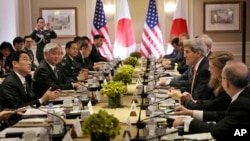The United States and Japan plan to expand their military cooperation under new guidelines that, for the first time in the history of the alliance, will allow Tokyo to project its power on a global scale.
U.S. Secretary of State John Kerry and U.S. Defense Secretary Ash Carter met Monday with their Japanese counterparts in New York before announcing the update to the defense cooperation agreement that had last been updated in 1997.
Kerry called said the new guidelines represent “an historic transition” in the relationship between the two countries.
“We mark the establishment of Japan’s capacity to defend not just it’s own territory but also the United States and other partners as needed,” he said.
It is a change also welcomed by Japan.
"The security environment surrounding Japan is becoming even more harsh and difficult,” Foreign Minister Fumio Kishida said. “We hope to promote a board-based Japan-US security and defense cooperation so the deterrents as well as response capability of the Japan-U.S. alliance will be further strengthened.”
A joint statement released Monday said the new guidelines will help the U.S.-Japan alliance continue to be a “cornerstone for peace and security” in the Asia-Pacific region while also serving as a “platform for a more stable international security environment.”
A senior U.S. defense official, speaking in Washington ahead of the issuance of the new guidelines, called the changes a “big deal,” noting Japan’s capabilities have increased significantly over the past two decades.
“This loosens the restrictions on what Japan can do,” he said. “What it means is that Japan could shoot down missiles heading for U.S. territory even if Japan itself is not under attack.”
Many details as to how the new guidelines will be put into effect still need to be worked out, but the updated guidelines envision Japan playing a greater role in peacekeeping missions as well as in responses to natural disasters and humanitarian relief operations.
Peacekeeping missions
In addition to expanded mutual defense provisions, the updated guidelines envision Japan playing a greater role in peacekeeping missions as well as in responses to natural disasters and humanitarian relief operations.
The provisions also call for more cooperation and information sharing in areas like intelligence, surveillance and reconnaissance, and cyberspace.
“Exactly where we do those and how we do it will be worked out as we work on the details of implementing the guidelines,” the U.S. official said.
The agreement also envisions increased cooperation in the development and production of defense technologies, which U.S. officials say they are eager to explore.
Analysts say the new guidelines are unlikely to play well with China.
“It's not going to welcome any changes to doctrine, guidelines that solidify the issue of how the US and Japan's militaries operate together,” said "IHS Jane's Defense Weekly" Asia-Pacific Editor James Hardy, noting Beijing has already reacted coolly to Washington pushing for Japan Maritime Self Defense Force operations in the South China Sea.
“I'd also expect China to play the 'militarism' card, saying that the U.S. is encouraging the latent Japanese empire-building urges of [Japanese Prime Minister Shinzo] Abe,” said Hardy.
China's reaction
U.S. officials say the changes to U.S.-Japan defense and cooperation under the new guidelines should not come as a surprise to China or other countries in the region as much of the discussion about the goals has been public. Still, U.S. officials say they expect to brief Chinese officials “in more detail” later this week.
U.S. Defense Secretary Ash Carter said the new guidelines are "not specifically aimed at China” but warned Beijing’s actions come with consequences.
“The Chinese behavior in the South China Sea, as one example, is interpreted by countries in the region as something that encourages their desire to partner with the United States,” he said. "The answer for this region isn't for anybody to throw their weight around.”
The new guidelines are also expected to help confront the increasing threat from North Korea, which has been conducting a growing number of nuclear tests and even conducted several missile tests prior to a recent visit to South Korea by the U.S. defense secretary.
U.S. officials believe the new guidelines, along with additional cooperation with South Korea and Australia, will help with “security and stability” on the Korean peninsula.
Already, the United States has started flying its Global Hawk unmanned aerial vehicles out of Japan’s Misawa Air Base on a rotational basis and has announced plans to send additional ballistic missile defense destroyers to Japan. This past December, the U.S. also deployed a new radar system to Japan to help detect ballistic missile threats.
Standing agreements
However, U.S. defense officials say, as a result of the new guidelines, they expect the level of U.S. forces in Japan to “decrease over time.” But they say they will be mitigated by increased abilities for the remaining forces.
The guidelines also do not envision any changes to existing agreements between the U.S. and Japan to relocate some U.S. forces from Okinawa to Guam as well as the construction of a new U.S. military facility at Futenma.
Under the revised guidelines, the two countries will work together through a new Alliance Coordination Mechanism (ACM), which will link the U.S. State Department and the Department of Defense with Japan’s Ministries of Foreign Affairs and Defense, as well as the U.S. military and Japan’s self defense forces. Officials say other departments and agencies will be brought in as needed.
U.S. officials also say the new guidelines will be “thoroughly consistent with Japan’s constitution.”








